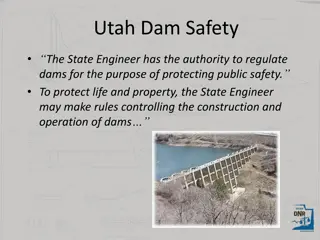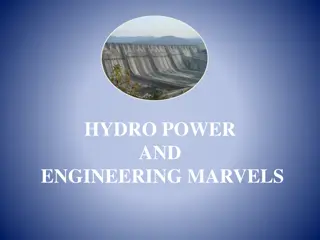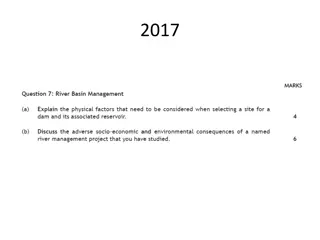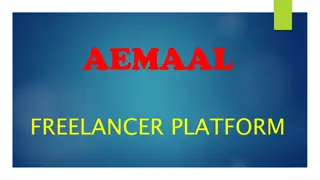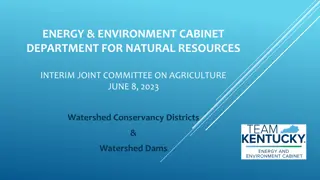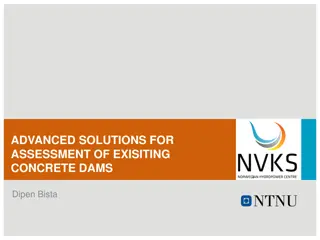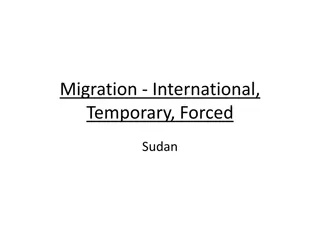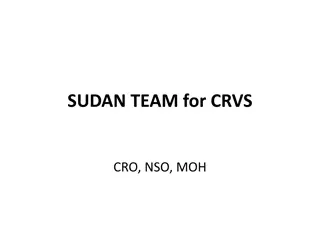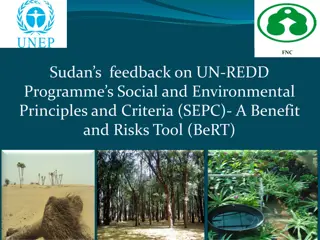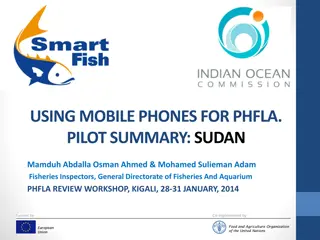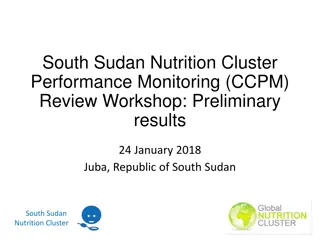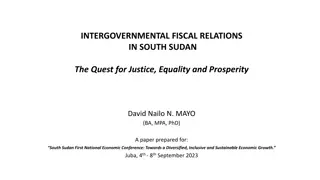Engineering Education and Large-Scale Dam Assessment: The Case of Merowe Dam in Sudan
This project, coordinated by the Polytechnic University of Catalonia and funded by the City Council of Barcelona, focuses on the global dimensions of engineering education, specifically in the context of algebra and large-scale dam assessment using the Merowe Dam in Sudan as a case study. The content touches on the importance of dams in achieving sustainable development goals, outlining both their positive impacts such as water supply and energy generation, as well as potential conflicts related to ecosystems and water use. It also discusses the historical and ongoing significance of big dams internationally, particularly in low-income countries like Sudan.
Download Presentation

Please find below an Image/Link to download the presentation.
The content on the website is provided AS IS for your information and personal use only. It may not be sold, licensed, or shared on other websites without obtaining consent from the author. Download presentation by click this link. If you encounter any issues during the download, it is possible that the publisher has removed the file from their server.
E N D
Presentation Transcript
Global Dimension in Engineering Education Algebra and Large-Scale Dam Assessment: The Case of Merowe Dam in Sudan Project coordination was carried out by the Polytechnic University of Catalonia This project is funded by the City Council of Barcelona
Global Dimension in Engineering Education TABLE OF CONTENTS INTRODUCTION CONTEXT BIG DAMS: A BRIEF GLOBAL PERSPECTIVE SUDAN AT A GLANCE THE MEROWE DAM ENVIRONMENT, SOCIAL AND HUMAN RIGHTS IMPACTS CLASSACTIVITY HOMEWORK ACTIVITY 2
Global Dimension in Engineering Education INTRODUCTION 2015: the UN GeneralAssembly adopted the 2030Agenda for Sustainable Development Crucial to harmonize economic growth, social inclusion and environmental protection Dams are often needed to achieve the social and economic dimensions of SD Positive impacts: Water supply (SDGs 6.1, 6.4) / Agriculture (SDG 2) / Jobs and industry (SDGs 8, 9) / Domestic use (SDGs 1, 3, 5, 11) / Energy generation (SDG 7) / Flood and drought protection (SDG 11.5) Potential conflicts: Ecosystems (SDGs 6.6, 15), in different sectors of water use and between communities (SDG 11) 3
Global Dimension in Engineering Education CONTEXT: BIG DAMS: A BRIEF GLOBAL PERSPECTIVE Complex context: several actors, distinct factors and geographical regions all together Popular in low income countries seeking to meet the triple challenge of state-building, nation-building and economic development E.g. General Franco (Spain), Nehru (India) or GamalAbdel Nasser (Egypt) 1970s onwards, dams were contested (corruption, benefit overestimation, dark side) 2012, dams comeback (China, India and Brazil, top 3 builders and raising powers) Dams are an integral part of water and food security strategies Land and water are becoming the world economy'sAchilles heel 4
Global Dimension in Engineering Education CONTEXT: SUDAN AT A GLANCE Sudan or North Sudan (after south Sudan's independence in 2011 following the Sudanese Civil War; south Sudan is now officially the Republic of the Sudan) Third largest country in Africa with an estimated population of approximately 40 million people (UN-DESA, 2017) Human Development Index (HDI) = 0.49 (165 / 185) GINI coefficient = 0.35 (1 means that one person has all the income) 5
Global Dimension in Engineering Education CONTEXT: SUDAN AT A GLANCE Social issues (UNICEF, 2014; UNDP, 2014) 6% and 8% dropout (from 3 mill. school-age children ) in primary and secondary Only 40% of the education sector s needs are funded Gender discrimination (90% subjected to female genital mutilation; 48% are illiterate, 14.1% integrates the labour force and GII 135thout of 155) Environmental issues Central and the northern regions have extremely dry desert areas (agriculture and nomadic activities) Nearer to the Nile River (well-irrigated farms growing cash crops) 6
Global Dimension in Engineering Education CONTEXT: SUDAN AT A GLANCE Economic issues 17thfastest-growing economy in the world due to oil profits (2010) Phase of stagflation (South Sudan secession, containing 80% of Sudan's oilfields) Agricultural remains the most-important sector (80% workforce and 30% GDP) Low worldwide agricultural prices ensure population living below the poverty line Governance issues Hydro-infrastructure construction on the Nile is related to the consolidation of political and economic power by the ruling elites during the colonial period After independence in 1956, the elites maintained the status quo 1989: Sudan s current Islamist regime (Harrakat al Islamiyya), with its fundamental project of economic salvation (Al-Injaz) 1999: Sudan s Dam Programme and Dam Implementation Unit (DIU) , yielding an exceptional power 7
Global Dimension in Engineering Education CONTEXT: THE MEROWE DAM Purpose and construction Built between 2003 - 2009 Hydropower generation and agriculture (contains 20% of the Nile's annual flow) Conflict of interests (German company Lahmeyer International provided positive EIA, being the primary project consultant as well) 2002: Green light to the project (after many years of discouraging studies and difficulty of finding willing financers) 8
Global Dimension in Engineering Education CONTEXT: THE MEROWE DAM Global actors Gulf Arab States, Egypt and China (financial investment, construction support, and political support ) Constructors Lahmeyer International (German): consultancy services Sinohydro (China): technical input for the implementation CMMD (Chinese consortium): dam structures construction Harben Power Engineering (China): transmission lines and substations construction Alstom (French): dam s 10 turbine installation ABB (German-Austrian): transmission system design and installation 9
Global Dimension in Engineering Education CONTEXT: THE MEROWE DAM Funders and financers (DIU, 2007) INVESTOR FUND (Million $US) Government of Sudan 1,114 Government of China 608 Arab Fund for Economical and Social Development 477 Saudi Fund for Development 215 Abu Dhabi Fund for Development 210 Kuwaiti Fund for Economical Development 200 Sultanate of Oman 106 State of Qatar 15 Total 2,945 10
Global Dimension in Engineering Education CONTEXT: ENVIRONMENT, SOCIAL AND HUMAN RIGHTS IMPACTS Environmental impacts Sedimentation, greenhouse gas emissions from decomposing organic matter, biodiversity loss and disrupted fish migratory patterns, irrigation (in)feasibility, and deteriorating water quality Social impacts The area inundated was home to over 75,000 inhabitants Compensation and resettlement was characterized by a lack of transparency and consultation of affected people (absolute power of DIU) Human Rights impacts Protests met by force (3 killed and 50 injured in 2006) Companies stood resolutely on the sidelines, refusing to intervene (exceptABB) 11
Global Dimension in Engineering Education ACTIVITIES CLASSACTIVITY Groups of 3-4 students Block I: Reflection and final sharing Block II: simplified problem resolution translated into algebraic terms HOMEWORK ACTIVITY Groups of 3-4 students Completion of class activity (Block II) 12
Global Dimension in Engineering Education CLASS ACTIVITY Block I 1. presented) that most attracted your attention? Which is the aspect (from all the circumstances, impacts, and facts that you have been 2. legal or moral, to ensure that the dam s environmental and social impacts are minimized? If a company supplies turbines for a hydroelectric dam, does it have a responsibility, 3. manufacture of the turbine is environmentally sound and without human rights impacts? Or do its ethical policies and legal obligations extend only to ensuring that the 4. What about other actors involved in the dam or any other project? 13
Global Dimension in Engineering Education CLASS ACTIVITY Block I 5. money they provide for projects does not facilitate adverse environmental impacts and human rights abuses? For example, banks and financial institutions - do they have a duty to ensure that the 6. is requested List direct and indirect impacts (positive or negative) associated with dam construction 14
Global Dimension in Engineering Education CLASS ACTIVITY Block II Government of Sudan: build a new dam to meet water requirements for irrigation Maximum expected dam capacity will be 5 km3(5 units of water) Yearly contribution in units of water Water demand Irrigation: 2 water units per year Other uses: 1 water unit per year 15
Global Dimension in Engineering Education CLASS ACTIVITY Block II Conditions If the state of the reservoir plus the water intake of the river is less than 3 water units, less quantity of water must be let out, thus affecting the irrigation schemes If the reservoir is full, any excess will be taken through the spillways (surplus water dumps). The minimum state may not be less than 1 water unit Students should: 1. Model the problem using a discrete linear dynamical system 2. Use a matrix equation of type p(k+1) = A p(k) 3. Describe the probable yearly transition of the units of water 16
Global Dimension in Engineering Education HOMEWORK ACTIVITY Class activity as starting point 1. Obtain the remaining terms pij and specify how this process was carried out. In addition, the resulting system should be presented 2. Assuming that the initial situation of the dam is related to a level of 3 units of water, what is the probability to be at the minimum level two years later? 3. Study the asymptotic behaviour of the system. Is the dam sustainable? 4. Provide an assessment in the context of the problem, in terms of results and knowledge acquired 17
Global Dimension in Engineering Education EVALUATION Class activity: A written report will be submitted, answering the questions raised in relation to both blocks Homework activity: a report will be requested from each group in which the entire activity should be solved Both deliveries will be evaluated based on the proposed rubric 18
Global Dimension in Engineering Education EVALUATION: RUBRIC 19
Global Dimension in Engineering Education Project: Integrate and Promote Global Issues in Scientific-Technical Education



